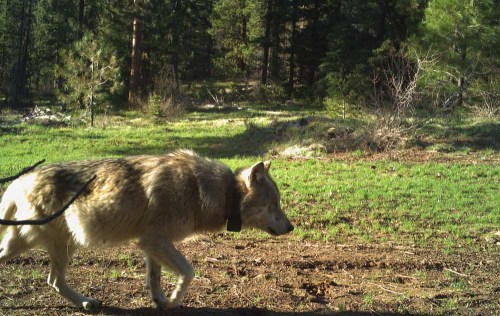New studies go ‘CSI’ to gauge wolf impacts
Published 3:05 pm Thursday, January 5, 2023

- Washington Department of Fish and Wildlife and the University of Washington are conducting a five-year joint research project on the food web involving deer, elk and moose populations and their predators.
OLYMPIA, Wash. — Scientists are beginning to untangle the complex — wolves, cougars, bears, coyotes, bobcats and humans.
A major five-year joint research project conducted by the Washington Department of Fish and Wildlife and the University of Washington is producing numerous peer-reviewed studies that will be pulled together in a report to the state Legislature this spring.
Trending
Donny Martorello, science division manager for WDFW’s Wildlife Program, said after wrapping up their field work in 2022, UW students have been working on graduate dissertations and peer-reviewed studies, which are now being published.
“Once all that is done by mid-spring, then we’ll have the exciting opportunity to sit down and say, ‘What does it all mean?” he told the Washington Fish and Wildlife Commission on Dec. 9.
He said the state agency will be considering whether the studies are able to answer questions about the impact of wolves, and can be used in management decisions.
Through the Predator-Prey Project, scientists put radio collars on the predators and their prey in two parts of Washington — the northeast corner, where wolves have become commonplace, and the north central part of the state, where wolves are still repopulating the area.
Students and biologists collected and analyzed data from 660 GPS-collared animals, 2,500 scats and 350 wildlife cameras from 2016 through 2021. They investigated more than 600 sites where deer and elk died, set up 150 cameras at kill sites to see who returned, and surveyed vegetation to analyze the quality of habitat at 260 sites.
Concerns prompt study
Trending
The research was initiated largely by hunters and conservationists who worried the deer and elk populations may not withstand the added stress from a growing population of wolves, especially in northeastern Washington, where 22 of the state’s 33 packs reside.
In 2015, lawmakers from that region heeded their constituents’ concerns and proposed a bill directing WDFW and UW to study the impact that wolves are having on the state’s ungulate species.
Sen. Shelly Short, R-Addy, was a state representative at the time and the prime sponsor of a bill to study the wolves’ impact.
She said although it never passed the Legislature, the bill led to a budget provision in 2016 to fund the project.
Short said she pushed for the law because wolves — absent for 80 years — moved back into the state and were growing in number every year.
According to the state’s most recent annual report on wolves, there were at least 206 wolves in Washington in 2021, and the population had grown by an average of 25% each year since first reappearing in 2008.
“We have this high apex predator back in our environment. So, how are other predators responding? And are there enough ungulates? That was always the basis” of the joint research project, Short said.
Shifting dynamics
UW graduate student Taylor Ganz is attempting to figure out how wolves are impacting deer and elk for her doctorate dissertation.
She told commissioners that white-tailed deer and elk populations in the northeast corner of the state were not experiencing dramatic declines during the five-year study period, according to her modeling.
She explained that scientists don’t have numerical population estimates for deer and elk because they’re too hard to count, but she used data gathered through the project to assess changes in population.
Within the study area, which includes the territories of four wolf packs, the deer population seemed to be declining slightly, while the elk population was growing, she said.
Ganz cautioned, however, that numerous factors contribute to population growth, and noted the data for her study was gathered before an outbreak of hemorrhagic disease in the white-tailed deer population.
“This is a really complex system with a lot of dynamics going on,” Ganz said. “We did our very best to investigate as many of those as possible, but we definitely don’t have all the answers.”
Ganz said when there are population declines, it’s not usually caused by one factor. Deer in northeastern Washington experience severe winters, limitations in forage and a group of predators whose populations are also changing.
“The population dynamics from that five-year period that we studied doesn’t indicate that there’s anything concerning” about the slightly declining deer population, which is within normal parameters of fluctuation, she added.
Ganz is focusing on the northeast ungulates and what factors influence their mortality, seeking to answer how wolves, other predators, forage availability and changes in the landscape affect their survival and movement.
That required an analysis of why each collared animal died.
Ganz said some causes of death, such as being hit by a vehicle, may be relatively easy to confirm. But investigating a predator kill is more complex.
“We investigate the scene as rapidly as possible, basically playing CSI (“Crime Scene Investigation”) to try and figure out what happened,” she said.
Biologists mostly use bite wounds to confirm that an animal died of predation.
“As you can imagine it can be really hard to find this information, so there are many cases where we have an unknown cause of death, or were unable to confirm that an animal died of predation even though that may likely be the case,” Ganz said.
Tracks at the scene and patterns of consumption offer clues, but scavengers complicate their findings, Ganz noted.
To help, scientists also collected DNA samples.
Ganz said, surprisingly, of 46 adult female deer and 72 fawn mortalities in the northeast study area, none were confirmed to be killed by wolves.
“Now, we know from diet analyses that wolves are eating deer in this system, but because wolves very quickly consume a carcass, and disperse it, it can be very hard to confirm,” she said.
Some wolf kills were likely among the unknown causes.
Of the confirmed or unconfirmed-but-likely predations, cougars were found to be the largest predator of adult white-tailed deer. For fawns, cougars, coyotes and bobcats were the major confirmed predators.
Getting hit by a vehicle also was high on the list of confirmed fatalities.
Landmark report landing soon
While Short still awaits the report, she’s encouraged by the quality of work coming out of the project.
“As with all research, it’s never a one-and-done,” she said. “It’s very clear they thought about how they went about getting samples, and how thoroughly things were tested. I think it will provide a good piece of information.”
Short said the research also is raising new questions for her — such as whether the 36% annual survival rate for white-tailed fawns noted in Ganz’s study is unusual.
The lawmaker said while the number of wolves in the state’s northeast corner continues to grow, most people — including ranchers — have accepted their presence, as long as the state continues to manage them.
This project could help them do that, she said.









